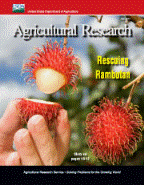United States Department of Agriculture: Agricultural Research Service, Lincoln, Nebraska

Agricultural Research Magazine
Date of this Version
3-2013
Document Type
Article
Citation
Agricultural Research March 2013
Abstract
With exotic names like ayote de caballo (a wild squash), friajolito (a wild bean), and teocinte (a wild relative of corn), Guatemala’s native plants seem very different from the agricultural bounty produced by farmers in the United States and other countries. But many of these native plants carry genes that may be vital to global food security. A new tool, developed by a team that includes Agricultural Research Service scientists, will make it easier to find and preserve these important plants. The tool is an interactive atlas designed to provide Guatemalan scientists and land managers with information on where these crop wild relatives grow, where they are relatively safe from habitat destruction, and which ones are rare and most at risk.
The genes these wild plants contain may prove useful in addressing threats posed by emerging diseases, insect pests, and temperature and rainfall extremes arising from a changing climate, says Karen Williams, a botanist with the ARS National Germplasm Resources Laboratory in Beltsville.
“Guatemala has many genetically diverse native plants closely related to some of our most important crops, including corn, beans, peppers, and potatoes. Some of these crop wild relatives are found only in Guatemala, and they have genes that equip them with survival mechanisms that may be useful to protect crops,” Williams says. Williams worked on the atlas for almost 10 years with César Azurdia Pérez from the Agronomy Faculty at the University of San Carlos in Guatemala, David E. Williams and Veerle van Damme from Bioversity International, and Andrew Jarvis and Silvia Elena Castaño from the International Center for Tropical Agriculture.
Included in
Agriculture Commons, Animal Sciences Commons, Food Science Commons, Plant Sciences Commons

